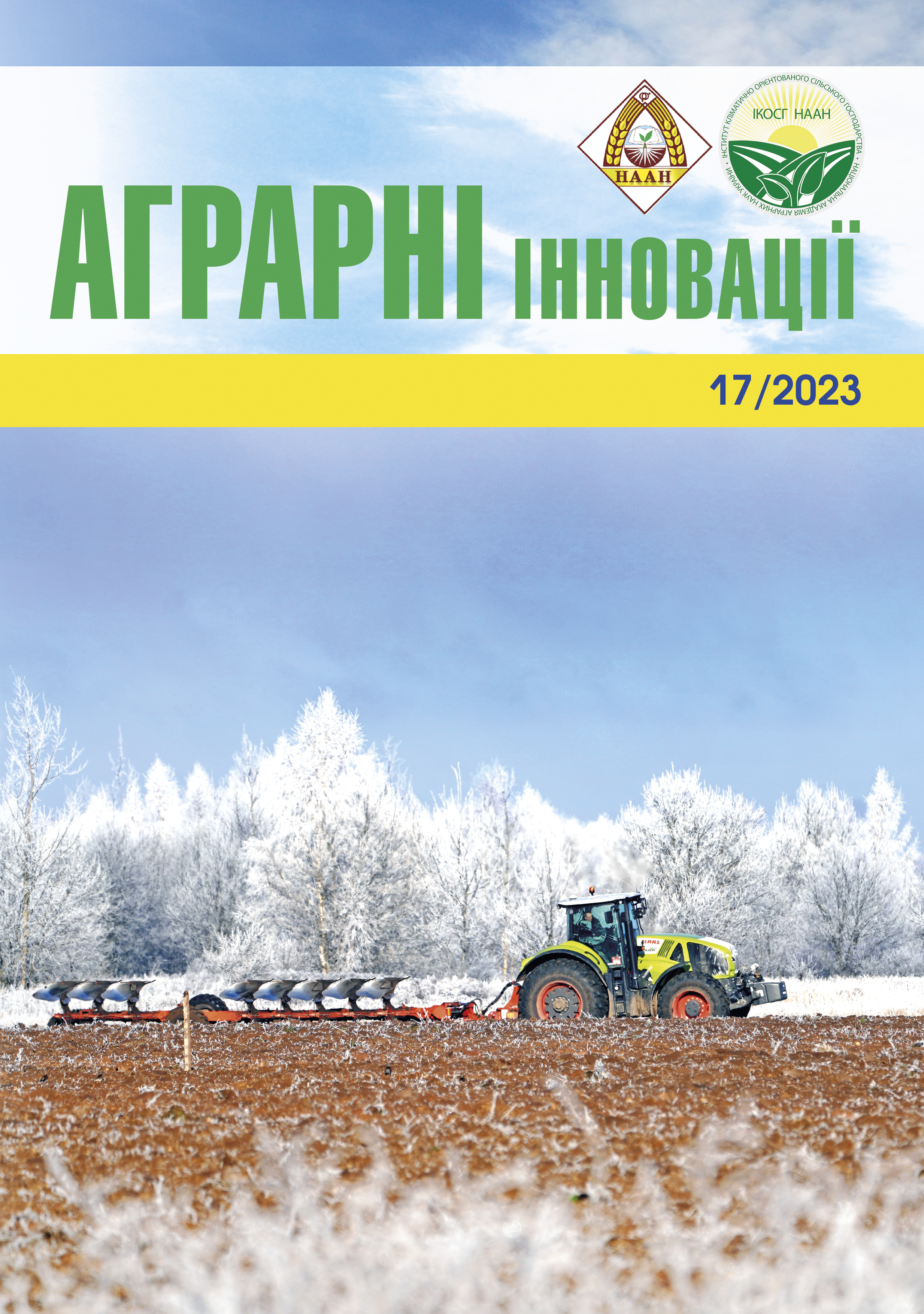THE INFLUENCE OF NITROGEN NUTRITION AND COMBINED PREPARATIONS ON THE CHARACTERISTICS OF WATER CONSUMPTION OF WINTER RAPE UNDER DIFFERENT GROWING CONDITIONS
Abstract
The purpose of the article is to establish the effect of different rates of nitrogen nutrition in combination with foliar treatment of plants with combined preparations on the dynamics of the water consumption process of winter rape, as well as the intensity of the plants' response to these factors. Research methods. To characterize the water regime of winter rapeseed crops during the spring-summer growing season, soil moisture was determined three times to calculate the productive moisture reserve. Experimental data were processed by the method of multivariate variance analysis according to V.O. Ushkarenko. Modeling of yield formation was carried out using the licensed software tool “Statistica 8.0”. Research results. Field experiments were conducted during 2012–2020 in non-irrigated conditions of the Voznesen district of the Mykolaiv region on ordinary lowhumus chernozems with a humus content of 3.2%. In the experiments, the Kronos winter rapeseed hybrid and the Black Giant variety were studied. Experimental plots were located in three repetitions in a row. The area of the experimental area was 2520 m2, and the accounting area was 600 m2. Sowing was carried out in the period from September 1 to 10 with a sowing rate of 1.0 million similar seeds per hectare. The predecessor was black steam. The scheme of experiments included options for earlyspring fertilizing with N60 and N90 nitrogen fertilizers, and foliar fertilizing with Vuksal Microplant® (a microfertilizer from the German company “Aglucon”) and the complex re-regulating drug Helafit Kombi® twice during the growing season of winter rapeseed plants. Conclusions. The results of the research proved that nitrogen fertilization and the use of combined preparations significantly increase the indicator of total water consumption, the difference between the extreme options in the amount of total water consumption was 328 m3/ha, or 14.4% more. According to individual factors, the growth of total water consumption was as follows: N60 recharge – by 5.2%; N90 – by 11.1%; the drug Vuksal – by 1.8%; drug Helafit Combi for twotime application – by 2.1%. Research results indicate that the water consumption ratio tended to decrease with the increase in total moisture consumption. It was established that with the dose of applied fertilizers N60, the water consumption coefficient decreased to 212–220, and with N90 – to 202–203 m3/t of biomass. With such a combination of factors, the best results were achieved with a combination of N90 nitrogen fertilization with a twotime application of Helafit Combi. In such a combination, the value of the water consumption coefficient decreased by 35 m3/t of dry biomass (18%). Accordingly, carrying out nitrogen fertilization with a dose of N90 in combination with the introduction of the multifunctional re-regulating drug Helafit Combi allows you to use moisture significantly more economically for the formation of organic biomass.
References
2. Домарацький Є. Глобальне потепління – палиця з двома кінцями для українських аграріїв. Матеріали міжнародної науково-практичної Інтернет-конфе- ренції «Стан і перспективи селекції в умовах змін клімату» 23 лютого 2018 року, тези доповідей. Херсон : Інститут зрошуваного землеробства НААН, 2018. С. 44–47.
3. Домарацький Є. О. Методи пом’якшення негативної дії водного стресу у рослин ріпаку озимого. Вісник аграрної науки Причорномор´я. 2018. Вип. 2. С. 39–45.
4. Гульванський І. М., Синицький С. Л., Мостіпан М. І. Ефективність комплексного використання азотних добрив та регуляторів росту рослин для позакореневого підживлення озимої пшениці. Вісник аграрної науки Причорномор’я. 2006. Вип. 4(1). С. 45–51.
5. Panfilova A., Gamayunova V., Smirnova I. Influence of fertilizing with modern complex organic-mineral fertilizers to grain yield and quality of winter wheat in the southern steppe of Ukraine. Agraarteadus. 2020. № 31(2). Р. 196–201. https://dx.doi.org/10.15159/jas.20.28
6. Домарацький Є. О., Базалій В. B., Домарацький О. О. Продуктивність ріпаку озимого залежно від азотного живлення та рістрегулюючих препаратів за умов кліматичних змін. Вісник аграрної науки Причорномор´я. 2019. Вип. 1. С. 53–62. (DOI: 10.31521/ 2313-092X/2019-1(101)-8).
7. Пророченко Т. І. Урожайність ріпаку ярого залежно від застосування в удобрення різних форм азотних добрив. Науковий журнал «Рослинництво та ґрунтознавство». 2018. Вип. 286, С. 74–79.
8. Деребон І. Ю., Малик К. В., Овдійчук В. П. Якість ріпаку озимого залежно від удобрення. Cільське господарство сьогодення (збірник тез доповідей Всеукраїнської науково-практичної конференції науково-педагогічних працівників, докторантів, аспірантів та молодих вчених, збірник 1). ЖНАЕУ, 2019. C. 129–131.
9. Томашов С. В. Мінеральні добрива під озимий ріпак як елемент технології вирощування. Современные научные проблемы создания сортов и гибридов масличных культур и технологии их выращивания : сб. тез. Междунар. конф. (г. Запорожье, 4–6 авг. 2009 г.). Запорожье, 2009. С. 76–77.
10. Шкода О. А., Біднина І. О. Урожай ріпаку озимого за різного рівня азотного живлення. Зрошуване землеробство : зб. наук. праць. 2014. Вип. 61. С. 91–93.
11. Шкода О. А., Біднина І. О. Ріпак озимий: умови для кращої перезимівлі. The Ukraine Farmer, 2014. Вип. 10(58). С. 58–59.
12. Заєць С. О., Василенко Р. М., Степанова І. М., Шаталова В. В. Продуктивність ріпаку озимого залежно від впливу різних компонентів препарату Мочекин-К в умовах Південного Степу України. Таврійський науковий вісник, 2013. Вип. 83. С. 52–55.
13. Домарацький Є. О., Добровольський А. В., Козлова О. П., Добровольський П. А., Лавришина О. Є. Шляхи оптимізації водоспоживання соняшника високоолеїнового типу за умов зміни клімату. Аграрні інновації. 2021. Вип. 10. С. 34–41.
14. Ревтьо О. Я., Домарацький Є. О. Оптимізація продукційного процесу агроценозів соняшнику за посушливих умов Південного Степу України. Аграрні інновації. 2021. Вип. 5. С. 68–74.
15. Методика польового досліду (зрошуване землеробство) [Methodology of field experiment (irrigated agriculture)] / за ред. Ушкаренка В.О. Херсон : Грінь Д.С., 2014. 448 с.
16. Вериго С. А., Разумова Л. А. Почвенная влага. Львов : Гидрометиздат, 1973. 328 с.






